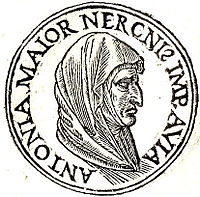Antonia the Elder

| Roman imperial dynasties | ||
|---|---|---|
| Julio-Claudian dynasty | ||
| Chronology | ||
|
27 BC – AD 14 |
||
|
AD 14–37 |
||
|
AD 37–41 |
||
|
AD 41–54 |
||
|
AD 54–68 |
||
|
||
Antonia Major also known as Julia Antonia Major[1] (Latin: Antonia Maior, PIR2 A 884) (born August/September 39 BC), also known as Antonia the Elder, was a daughter of Triumvir Mark Antony and Octavia the Younger and a relative of the first Roman emperors of the Julio-Claudian dynasty. She was a niece of the first emperor Augustus, step cousin of the emperor Tiberius, paternal great-aunt of the emperor Caligula, maternal aunt and great-aunt-in law of the emperor Claudius, and paternal grandmother and maternal great-great aunt of the emperor Nero.
Antonia was born in Athens, Greece and after 36 BC her mother, along with her siblings and herself were brought to Rome. She was raised by her mother, her uncle and her aunt Livia Drusilla. According to Cassius Dio after her father died, Augustus allowed her and her younger sister Antonia Minor to benefit from their father's estate in Rome. Although little is known of her, Antonia was held in high regard like her sister Antonia Minor, the mother of the emperor Claudius, who was celebrated for her beauty and virtue.
Progeny
Around 22 BC Antonia married the consul, Lucius Domitius Ahenobarbus. Antonia bore Lucius three children:
- Domitia Lepida the Elder - ancient sources refer to her as Domitia. She married the consul Decimus Haterius Agrippa and bore him a son Quintus Haterius Antoninus. Domitia later married Gaius Sallustius Crispus Passienus, consul suffect in 27, proconsul of Asia and consul in AD 44.
- Gnaeus Domitius Ahenobarbus (PIR2 D127) - consul in AD 32, he married his cousin Germanicus' daughter Agrippina the Younger in 28. Agrippina and Domitius were the parents of the emperor Nero. He was accused by Tiberius, but saved by that emperor's death (Suet. Nero 5) and lived a few years longer under Caligula's reign until he died in AD 40.
- Domitia Lepida the Younger (PIR2 D180) - she first married her cousin, the consul Marcus Valerius Messalla Barbatus to whom she bore a daughter, the empress Valeria Messalina, third wife of the emperor Claudius. After the death of her first husband, she married Faustus Cornelius Sulla Lucullus, suffect consul in AD 31, and gave him a son, Faustus Cornelius Sulla Felix (who would become consul in AD 52). At the beginning of Claudius' reign, she married Appius Junius Silanus, consul in AD 28, who was put to death in AD 42. She outlived her daughter, Messalina.
Many scholars think the Ara Pacis (an altar from the Augustan Era), displays Gnaeus Domitius Ahenobarbus and his elder sister Domitia. The woman behind Domitia and Domitius is allegedly their mother Antonia Major and the man next to Antonia Major is her husband Lucius Domitius Ahenobarbus.
Ancestry
| Ancestors of Antonia the Elder | ||||||||||||||||||||||||||||||||||||||||||||||||||||||||||||||||||||||||||||||||||||||||||||||||||||||||||||||||||||||||||||||||||||||||||||||||||||||||||||||||||||||||||||||||||||||||||||||||||||||||||||||||||||||||||||||||||||||||||||||||||||||||||||||||||||||||||||||||||||||||||||||||||||||||||||||||||||||||||||||||||||||||||||||||||||||||||||||||||||||||||||||||||||||||||||||||||||||||||||||||||||||||||||||||||||||||||||||||||||||||||||||||||||||||||||||||||||||||||||||||||||||||||||||||||||||||||||||||||||||||||||||||||||||||||||||||||||||||||||||||||||||||||||||||||||||||||||||||
|---|---|---|---|---|---|---|---|---|---|---|---|---|---|---|---|---|---|---|---|---|---|---|---|---|---|---|---|---|---|---|---|---|---|---|---|---|---|---|---|---|---|---|---|---|---|---|---|---|---|---|---|---|---|---|---|---|---|---|---|---|---|---|---|---|---|---|---|---|---|---|---|---|---|---|---|---|---|---|---|---|---|---|---|---|---|---|---|---|---|---|---|---|---|---|---|---|---|---|---|---|---|---|---|---|---|---|---|---|---|---|---|---|---|---|---|---|---|---|---|---|---|---|---|---|---|---|---|---|---|---|---|---|---|---|---|---|---|---|---|---|---|---|---|---|---|---|---|---|---|---|---|---|---|---|---|---|---|---|---|---|---|---|---|---|---|---|---|---|---|---|---|---|---|---|---|---|---|---|---|---|---|---|---|---|---|---|---|---|---|---|---|---|---|---|---|---|---|---|---|---|---|---|---|---|---|---|---|---|---|---|---|---|---|---|---|---|---|---|---|---|---|---|---|---|---|---|---|---|---|---|---|---|---|---|---|---|---|---|---|---|---|---|---|---|---|---|---|---|---|---|---|---|---|---|---|---|---|---|---|---|---|---|---|---|---|---|---|---|---|---|---|---|---|---|---|---|---|---|---|---|---|---|---|---|---|---|---|---|---|---|---|---|---|---|---|---|---|---|---|---|---|---|---|---|---|---|---|---|---|---|---|---|---|---|---|---|---|---|---|---|---|---|---|---|---|---|---|---|---|---|---|---|---|---|---|---|---|---|---|---|---|---|---|---|---|---|---|---|---|---|---|---|---|---|---|---|---|---|---|---|---|---|---|---|---|---|---|---|---|---|---|---|---|---|---|---|---|---|---|---|---|---|---|---|---|---|---|---|---|---|---|---|---|---|---|---|---|---|---|---|---|---|---|---|---|---|---|---|---|---|---|---|---|---|---|---|---|---|---|---|---|---|---|---|---|---|---|---|---|---|---|---|---|---|---|---|---|---|---|---|---|---|---|---|---|---|---|---|---|---|---|---|---|---|---|---|---|---|---|---|---|---|---|---|---|---|---|---|---|---|---|---|---|---|---|---|---|---|---|---|---|---|---|---|---|---|---|---|---|---|---|---|---|---|---|---|---|---|---|---|---|---|---|---|---|---|---|---|---|---|---|---|---|---|---|---|---|---|---|---|---|---|---|---|---|---|---|---|---|---|---|---|---|---|---|---|---|---|---|---|---|---|---|---|---|---|---|---|---|---|---|---|---|---|---|---|---|---|---|---|---|---|---|---|---|---|---|---|---|---|---|---|---|---|---|---|---|---|---|---|---|---|---|---|---|---|---|---|---|---|---|---|
| ||||||||||||||||||||||||||||||||||||||||||||||||||||||||||||||||||||||||||||||||||||||||||||||||||||||||||||||||||||||||||||||||||||||||||||||||||||||||||||||||||||||||||||||||||||||||||||||||||||||||||||||||||||||||||||||||||||||||||||||||||||||||||||||||||||||||||||||||||||||||||||||||||||||||||||||||||||||||||||||||||||||||||||||||||||||||||||||||||||||||||||||||||||||||||||||||||||||||||||||||||||||||||||||||||||||||||||||||||||||||||||||||||||||||||||||||||||||||||||||||||||||||||||||||||||||||||||||||||||||||||||||||||||||||||||||||||||||||||||||||||||||||||||||||||||||||||||||||
References
- ^ Minto, The Heliopolis Scrolls, p. 159
- E. Groag, A. Stein, L. Petersen - e.a. (edd.), Prosopographia Imperii Romani saeculi I, II et III, Berlin, 1933 - . (PIR2)
- J. Minto, The Heliopolis Scrolls, ShieldCrest, 2009
